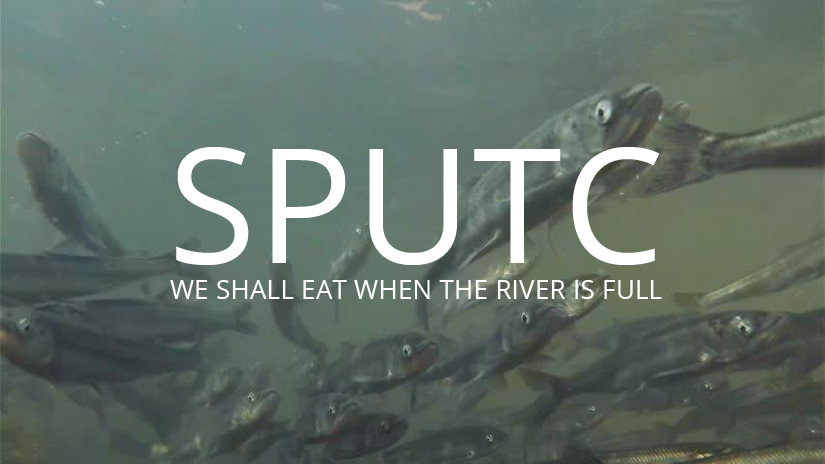Estimated Reading time

3 Mins
Nuxalk Stewardship and Research Featured in Sputc (Eulachon) Documentary
An upcoming documentary by Nuxalk filmmaker Banchi Hanuse shines a spotlight on the sputc (eulachon)—a fish essential to the cultural and physical well-being of the Nuxalk—and features research by Coast Funds’ director and Nuxalk scientist Ts'xwiixw Megan Moody.

A recent Coast Mountain News article looks at Nuxalk stewardship and research of the culturally and environmentally critical species sputc eulachon featured in the documentary being created by Banchi Hanuse Sputc: We Shall Eat When the River is Full.
It has been many years since Nuxalk Nation has seen sputc eulachon thrive in their territory. Historically, this species marked the start of spring each year that ended winter famine. It was, and continues to be, an important source of food and health.

Hanuse’s film is still in production. It brings a diverse experience of live action, animation, archival images, ancestral stories, and songs. Sputc: We Shall Eat When the River is Full is a cinematic tale of wealth, loss, and recovery.
A sputc eulachon pole was first raised six years ago in Bella Coola, Nuxalk territory and marked the beginning of an annual community ceremony that celebrates the time when sputc eulachon would traditionally return. Hanuse began filming the documentary at the same time and aims to finish the project in the coming year.
Featured in the documentary is the work of Nuxalk scientist and Coast Funds Director Ts’xwiixw Megan Moody who has conducted in-depth research on sputc eulachon. Ts’xwiiw Megan Moody’s research indicates that sputc eulachon returns began declining in the 1970s before crashing significantly in 1999. She points to several causes including climate change and trawlers in Queen Charlotte Sound that were catching 90 to 150 tonnes of sputc eulachon as bycatch by the trawling industry.
It is the Nations coast-wide that are leading the research to find out what is happening to eulachon. If it wasn’t for our research we wouldn’t know if eulachon still exist in our rivers.
“It is the Nations coast-wide that are leading the research to find out what is happening to eulachon,” says Moody, noting that the research is being conducted entirely by community members. “If it wasn’t for our research,” Moody says, “we wouldn’t know if eulachon still exist in our rivers.”
Bella Coola hasn’t seen a healthy sputc eulachon run since 1998, though numbers did begin to increase again in 2012. The decline resulted in loss of annual fishing, harvesting and preserving of this essential species. Historically, families would fill the beaches for these annual sputc eulachon rituals. Their harvests provided ‘grease’ for eating, for medicine, and for trading.
I was impressed by the dedication of the fisheries group to never miss a day in their endeavor to collect samples and to better understand the eulachon. I was also impressed by the resiliency of the Nuxalk people. I really saw how much the loss of the eulachon affected them and how much that this little fish means to them as not only a source of food but medicine for the people.
The live action filming for this documentary is by Haitian/Canadian cinematographer Louvens Remy. This project is the third film he has worked on in Bella Coola. Remy reflects that the most enjoyable part of the filming has been joining the Nuxalk Fisheries staff on their sputc eulachon study.
Remy remembers being refreshed and becoming adapted to the elements by what would have otherwise daunting 4 a.m. starts to their filming days. “I was impressed by the dedication of the fisheries group to never miss a day in their endeavor to collect samples and to better understand the eulachon. I was also impressed by the resiliency of the Nuxalk people. I really saw how much the loss of the eulachon affected them and how much that this little fish means to them as not only a source of food but medicine for the people,” said Remy.
Nuxalk Nation is one of the many First Nations leading conservation and stewardship efforts by combining traditional stewardship practices with modern science and regional monitoring that protects and restores ecological integrity across the coast.
Through investments with Coast Funds, First Nations have conducted 291 scientific research or habitat restoration initiatives on 62 different species, including whale, bear, wolverine, salmon, herring, and of course, eulachon. Learn more about species research and restoration initiatives by First Nations.
First Nation initiatives are resulting in robust research, habitat protection and restoration, and monitoring of key species and resources. These programs help to protect First Nations’ values and traditions, ensuring that resources and natural surroundings are sustained for future generations.

